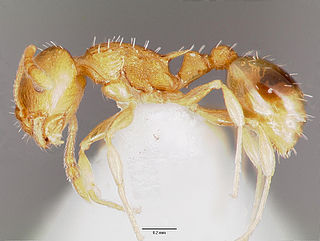
Edward Osborne WilsonForMemRS was an American biologist, naturalist, ecologist, and entomologist known for developing the field of sociobiology.

Fire ants are several species of ants in the genus Solenopsis, which includes over 200 species. Solenopsis are stinging ants, and most of their common names reflect this, for example, ginger ants and tropical fire ants. Many of the names shared by this genus are often used interchangeably to refer to other species of ant, such as the term red ant, mostly because of their similar coloration despite not being in the genus Solenopsis. Both Myrmica rubra and Pogonomyrmex barbatus are common examples of non-Solenopsis ants being termed red ants.

Carpenter ants are large ants indigenous to many forested parts of the world.

Myrmica is a genus of ants within the subfamily Myrmicinae. It is widespread throughout the temperate regions of the Holarctic and high mountains in Southeast Asia.

Cardiocondyla is an Old World genus of ants in the subfamily Myrmicinae.

Harpagoxenus canadensis is a species of ant in the subfamily Myrmicinae. It is found in Canada and the United States.

Harpagoxenus sublaevis is a species of ant in the subfamily Myrmicinae. It is found in Austria, France, Germany, Italy, and Switzerland.

Monomorium is a genus of ants in the subfamily Myrmicinae. As of 2013 it contains about 396 species. It is distributed around the world, with many species native to the Old World tropics. It is considered to be "one of the more important groups of ants," considering its widespread distribution, its diversity, and its variety of morphological and biological characteristics. It also includes several familiar pest species, such as the pharaoh ant and the flower ant.

Liometopum is a genus of ants that belongs to the subfamily Dolichoderinae, found in North America, Europe and Asia.

Atta cephalotes is a species of leafcutter ant in the tribe Attini. A single colony of ants can contain up to 5 million members, and each colony has one queen that can live more than 15 years. The colony comprises different castes, known as "task partitioning", and each caste has a different job to do.

Protanilla is a genus of subterranean ants in the subfamily Leptanillinae. Known from the Indomalayan realm, the genus contains about thirteen species. The genus was erected by Taylor (1990) for the type species P. rafflesi, described from workers from Peninsular Malaysia. Species in this genus have long and downcurved mandibles with peg-like tooth on the inner margins. Four species are known from China, one from Taiwan, one from Sri Lanka and a couple from India.

Blepharidatta is a rare Neotropical genus of ants in the subfamily Myrmicinae. The genus, formed by predatory species whose small colonies nest in soil or leaf-litter, has up to seven species, but most of them are waiting for a formal taxonomic treatment or confirmation.
Gaoligongidris is an Asian genus of ants in the subfamily Myrmicinae. It contains the single species Gaoligongidris planodorsa, collected in the Gaoligong Mountains, Yunnan Province, China. The genus is known only from workers and nests in the soil, and forages on the ground. While similar to the genus Lophomyrmex of the tribe Attini, Gaoligongidris is most closely related to the Indo-Australian Lasiomyrma, tribe Crematogastrini.

Myrmelachista is a Neotropical genus of ants in the subfamily Formicinae. The genus is found exclusively in the Neotropical realm. Little is known regarding their biology.
Furcotanilla is a genus of ants in the subfamily Leptanillinae containing the single species Furcotanilla furcomandibula. The genus is close to Protanilla, from where the type species Protanilla furcomandibula was transferred from by Xu (2012). Its only species is known from Yunnan, China, where it nests in the soil and forages on the ground. Queens and males are unknown.

Proiridomyrmex is an extinct genus of ants in the subfamily Dolichoderinae. The genus contains two species; Proiridomyrmex vetulus, described in 2002 where its fossils were discovered in the United States, and Proiridomyrmex rotundatus, described in 2015.

Pseudoneoponera is a ponerine genus of ants found from India to Australia, they are mostly non queen species, most of the species within the genus thrives on only gamergates.
Dolichoderus diversus is a species of ant in the genus Dolichoderus. Described by Emery in 1894, the species has a widespread distribution in multiple countries, including Brazil, Colombia, Costa Rica, Ecuador, Guyana, Mexico, Panama, Trinidad and Tobago and Venezuela.

Temnothorax curvispinosus, the acorn ant, is a species of ant in the genus Temnothorax. The species is common and widely distributed in eastern United States, where they tend to inhabit forested areas. The ground-dwelling ants build their nests in plant cavities, in the soil or under rocks. It is sometimes called the acorn ant because it can live inside hollowed out acorns.
















